
Dynamic Stability System - another few steps further on
Progress continues on several fronts with designer Hugh Welbourn’s revolutionary Dynamic Stability System. For those still uninitiated, DSS-equipped yachts use a retractable foil to leeward to generate stability, this in turn enables the boat to carry a smaller bulb and require less form stability, dramatically reducing their displacement with all the resultant performance benefits (read more here). And, yes, it does work!
At the Bol d’Or Mirabaud last year on Lake Geneva we were impressed to see now initially doing a horizon job on the fleet was a tiny 28ft monohull. Michi Aeppli’s DSS-equipped Quant 28 led the huge Swiss fleet down the Petit Lac to Versoix before she was finally picked off by the first of the D35 catamarans.
Heralding from Zurich, Aeppli is a lifelong sailor and windsurfer, whose many previous boats have included a Grand Surprise, a popular one design in Switzerland and more recently an Onyx - a 8.5m long purpose-designed and built lake racer, featuring a giant rig and bowsprit supported on a slender hull, displacing around 1,000kg. In this Aeppli won his class in Switzerland’s top event, the Bol d’Or Mirabaud.
However when he first read about the DSS system and went for a sea trial with Gordon Kay on the 27ft DSS demonstrator back in 2008, Aeppli was hooked. It wasn’t until the spring of 2010 that Hugh Welbourn, the brains behind the DSS system, met up with him to discuss the design of a lake racer. Welbourn was well familiar with such boats having raced the Bol d’Or several times with Jo Richards aboard various Full Pelts. They established a suitable design, emphasising performance in very light conditions (as Aeppli puts it “75% of the time we sail in less than 6 knots of wind”), and for reasons of cost they chose to have the new Quant 28 built in Cowes by Paul Jennings, the boat ultimately completed by Kevin Costin in Switzerland.
Aeppli campaigned the Quant 28 on the Swiss lakes throughout 2011, dominating all his local races in Zurich and in the larger fleets on Lake Geneva regularly finishing among monohulls substantially larger. Top results included a second place in class in the Geneve-Rolle-Geneve, which he only lost to a 38 footer, something he put right in 2012 winning his class both on handicap and on the water.
Ever since he sailed the 27ft demonstrator Aeppli had been so taken with the DSS system that he has wanted to become a distributor for it. And so the Quant 30 came into being, a production boat designed principally for lake racing, the first examples currently under construction in Falmouth.
Compared to the 28, of the 30, designer Hugh Welbourn says: “We have gone a little bit bigger and a little bit sleeker generally. It’s a production boat for people who aren’t necessarily top drawer sailors. It is fractionally detuned, just to make it easier for people to sail, but it will still be plenty quick.”
Vital statistics for the Quant 30 are impressive. Thanks to the DSS providing a substitute, areas where conventional monohulls gain their stability – the hull form and the bulb - have been much reduced. As a result the beam of her hull is just 1.95m (compared to 2.5m for a Melges 24 or 3.05m for a Mumm 30), although racks extend this to 3.6m. Meanwhile her bulb weighs just 280kg, around the same as that of the 6ft shorter Melges 24, but substantially less than a Farr 30’s 950kg. As a result the Quant 30’s all-up displacement is a feather weight 700kg (compared to the Melges 24 at 809kg or the Farr 30’s 2,000+kg).
 |
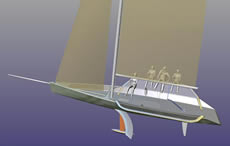 |
A significant departure is that the Quant 30 has twin curved foils, rather than a single board passing laterally through the boat, as other DSS boats have. Despite being curved, the foils are deployed like a daggerboard (ie they pull out and in, rather than articulating like a centreboard) extending out laterally to around the limit of the racks.
The reason for having twin boards, says Welbourn, is so that they can be fully retracted when the boat is moored or being towed. They also eliminate some of the drag of the single board arrangement as they retract completely into the hull. Equally if you want to go out for a blast sailing two up for example, both foils can be deployed like training wheels, taking the hassle out of tacking them. Welbourn reckons that in a breeze they will also race in anger with both foils deployed all the time. “Upwind the weather one with the heel on will be out of the water and when you go downwind you’ll have a nice balancing act - you’ll be flying the boat just a little bit more than we were previously.”
The twin boards are a slight compromise for ease of use, but Welbourn says they will work fine. “It helps in some aspects - there is a weight overhead by going to two instead of one, but it’s not as bad as you’d think because they can be cantilevered rather than having to be the same strength all the way through. Also you get rid of the rollers.”
Another advantage of having twin boards is that it makes it easier for the designer to fix the orientation of the boards relative to the hull without the worry of how one single board will run through the boat. This has allowed the boards to be more immersed (Aeppli reckons the tips are about 10-12cm lower than they are on the Quant 28). In terms of their profile, the boards are symmetric so that the same mould can be used for both.
Another compromise to improve the handle-ability is that the Quant 30 features a heavier bulb, up to 280kg from the 28's 170kg, even though the all-up displacement of the 30 is still only set to be 700kg.
Performance-wise, the narrow hull shape, lightweight plus an ultra lightweight 12.15m tall rig supporting 47sqm of sail upwind and 100sqm downwind, will make the boat a weapon in light winds when the boards are stowed. The boards are expected to be deployed above around 9 knots and in 10-15 knots the Quant 28 has already demonstrated that she will readily sail at 1.5x wind speed. As the video below shows when the breeze is fully up, the 28 sails with very little of her hull remaining in the water, dramatically reducing parasitic drag.
We have sailed both the 27 DSS demonstrator and the Infiniti 36 DSS boat although we have yet to sail one in big breeze. But with both boats there is no sensation of yawing around the foil or of it creating lee helm. The only noticeable difference in feel the foil provides is that it pins the boat to the water more, making it pitch less when going through waves, as in the same way as the curved foils found in the floats of ORMA 60s and MOD70s do. When you step on board the Quant 28 at the dock, the boat is so light that it heels to your weight like a dinghy, although this will be less evident on the 30 with its higher displacement ratio.
Although the Quant 30 is designed for the Swiss lakes, construction of the new boat – of which three have already been sold - is well underway in Falmouth at Boat Developments. Carbon fibre is being used throughout, with the hull being laminated within a female mould and the deck built in flat panels.
Beyond the foil arrangement, other neat features of the boat is that the racks and trampoline fold up level with the boom when in harbour. Also the foredeck is open making it easier for the bowman (there are typically five crew) to do his job.
The first Quant 30 is due for launch in April with boats two and three launching soon after.
Making a non-lake version of the Quant 30 that for example might be used in the UK is not on the cards but wouldn’t require that much alteration, says Hugh Welbourn. “If we did a UK version, so coastal or Solent racing/sailing in effect, then I'd reckon to add a bit more into the hull laminate and maybe slightly heavier bulb but keep the rig as is most likely or only take off a little there.”
An issue will be her handicap: ORC seems to be looking at the DSS system much more favourably than IRC at present. As Welbourn says IRC still doesn’t like light boats. “They said they were going to make light boats more competitive in the smaller sizes, but it is hard to see any evidence that that has happened. If anything you’d say, it has gone the other way.”
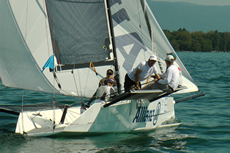 |
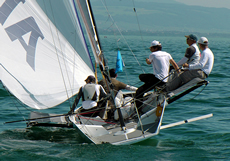 |
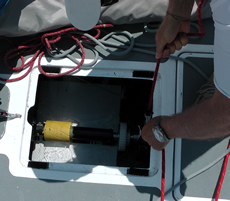 |
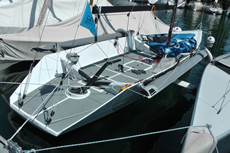 |
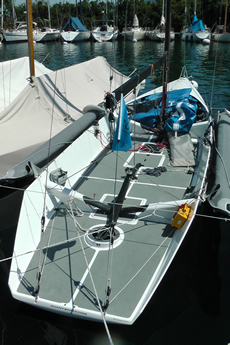 |
Read more about the Quant 30 here
Mini
Another small boat that is likely to create an equal stir this year is the DSS-equipped Mini. Built by Isotop Composites in France (the go-to people when it comes to carbon fibre rudders), where proprietor Dominique Pedron is a DSS convert, the boat was built in 2010 (and displayed at La Rochelle boat show that year), but has yet to be finished off.
As Welbourn explains: “It has got to the stage where it starts costing money to fit it out. Hopefully he [Pedron] can find a sponsor so they can just get on with it.” They are hoping that the boat will be finished off and launched early this season so it can compete in this September’s Mini Transat.
The DSS Mini looks very very different from all other Minis. While most are bullet-shaped to make the most of the 3m maximum beam permitted by the class rules on their tiny 21ft LOA, the DSS Mini, due to the stability gained from her foil, is narrow and also isn’t equipped with a canting keel, now standard fit on most Mini Protos.
The 3m maximum beam limitation of the Classe 6.50 rule is not ideal as it also limits the wingspan of the DSS foil and as Welbourn puts it: “The most interesting trade-off you have to work through is how much wing and how much hull.” Nonetheless it will fascinating to see how she performs against standard Protos this season, for she will certainly be the lightest Proto in the fleet by a significant margin.
Welbourn keeps his cards close to his chest when it comes to talking specifics of her performance compared to regular Protos. “Put it this way - when I started looking at it seriously for a Mini Transat, we thought this would work very nicely thank you very much. Obviously in the light stuff, it is brilliant because it is light and skinny. It is a low drag animal, that is the key thing, as are all the boats we are doing. If you are low drag you need less of everything to make the thing work.”
And what works in the Mini class, typically ends up in the IMOCA class, although at this time when that class is teetering on the brink of going one design, one wonders how an innovation such as this would go down.
 |
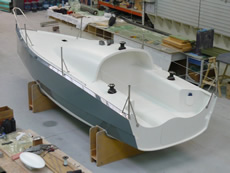 |
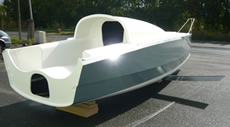 |
 |
Infinity 36 pics by Quin Bissett/Q&K/www.q-and-k.com
Infiniti 36
At the opposite end of the size range, Monaco-based company Infiniti has been set up to sell bigger DSS boats to the luxury end of the market with a range of ultra-fast yachts that intend to ‘out-Wally Wally’, with considerable cost savings achievable simply though their having substantially less displacement.
Charging around the Med this summer has been the Infiniti 36 GT demonstrator, built by Danish Yachts. A second example is currently under construction, due for launch in March/April which will have more of a racing rig including EC6 rigging and a little less displacement. This will have the same hull and deck but with a revised foil drive mechanism, that will runs on a series of cogs keying into a small track on the underside of the foil - a lighter solution that should be easier to maintain.
“We’re quite relieved because it is about the hardest size for a DSS boat to make it work,” says Welbourn of the 36. “It is one of those things about scale factor and physics. It is bigger than a big dinghy, so your crew-type righting moment isn’t having the sort of the effect as on the Quant, but it’s not a big enough boat to start to get grunty of its own accord. So given the fact that it has worked, better than I could have hoped, we are very pleased.”
Again the 36 is narrow and light, with a beam of 2.95m (compared to 3.61m of a Mumm 36) and displacement of just 2.3 tonnes (or 3.72 for the Mumm 36) and features the more conventional single asymmetric DSS sliding foil. Compared to a more contemporary boat the Infiniti 36 is almost a tonne lighter than the already lightweight McConaghy 38, while the 36 is also fitted with an engine and structurally is Cat1, built with a foam rather than Nomex core.
The boat’s major race last season was the Palermo-Monte Carlo, for the most part a profoundly light race in which they finished fourth behind the 100ft maxi Esimit Europa II, a Cookson 50 and Kuka Light (the new Doug Schickler-designed canting keel 42 footer run by newbie monohull sailor Mitch Booth). “We duffed up the three Class 40s and before the Shipman 63 sank we were 30 miles in front of it,” recounts Gordon Kay, who skippered the boat. “We had a bunch of guys who jumped on the boat, they’d never sailed it before in their lives. We didn’t have a comprehensive light air sail inventory - we needed an A0 and a wind seeker and a light jib. And apart from us there was only one smaller boat and they retired after one day.”
When the breeze is up, the numbers the 36 has been achieving have been impressive. “Basically if it is blowing 20 knots, the boat will be doing 20 knots and 25 knots the same. Downhill it will always do wind speed or more and that isn’t just down a wave, that is solid speed,” says Welbourn. And once again in light conditions the narrow hull pays dividends.
According to Gordon Kay they are regularly seeing 7-8 knots upwind, but also good speeds upwind when it is light. “Once we crack sheets, two sail reaching, we see a lot of 18s in mid-teens breeze. We’ve been out with guests and in 15 knots of breeze we were doing 14 knots, not trimmed that well or with people hiking. But the impressive thing is how it feels in a sea state. We used to chuck the 27 around in big waves but this is a proper boat and this is just so easy to go quickly. When you are onboard, you think it is a bigger boat. 25 knots offshore in quite big waves, it is a little boat and yet when we are running we are not hanging on to the back of the boat.”
Kay adds that downwind in big conditions it is possible to sail the 36 with a kind of multihull technique where instead surfing down waves, the foil provides enough stability to head up going down waves for this causes the boat to accelerate, in turn causing the foil to create more lift. He explains: “Normally you are trying to go in front of the wave to get a boost or a surf from it. With this you are always looking for the flat water part where the wave was. It accelerates like hell, and then it is a case of keeping the speed and going around the back of the wave and over the other side. It is different to lead mines.”
Over the winter the 36 is having some tweaks, with the standing rigging being replaced with PBO and a fibre optic load sensor installed in the foil ready for testing this month.
A ‘big announcement’ is expected imminently regarding a large Infiniti project and we’ll be bringing this to you once it’s been confirmed.
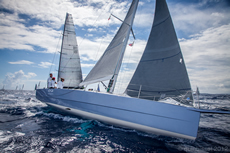 |
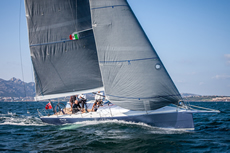 |
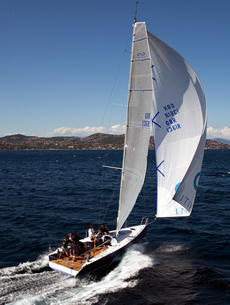 |
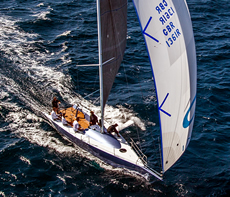 |
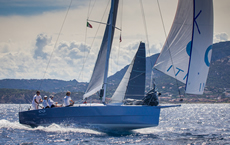 |
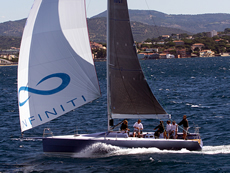 |
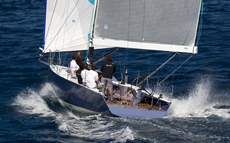 |

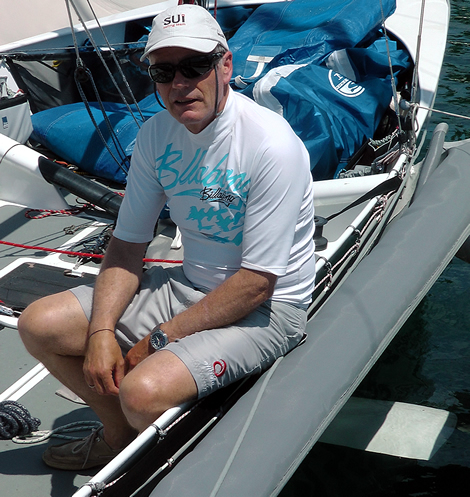

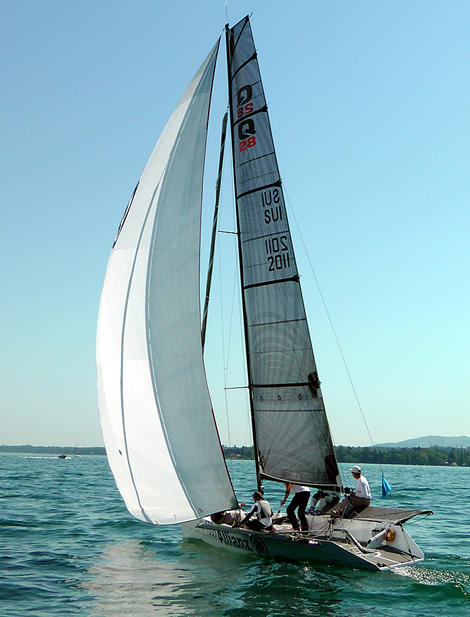

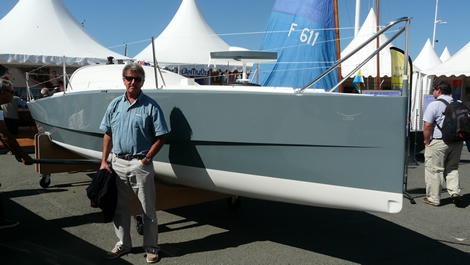
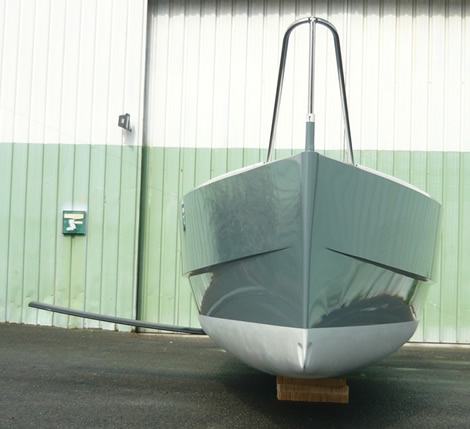
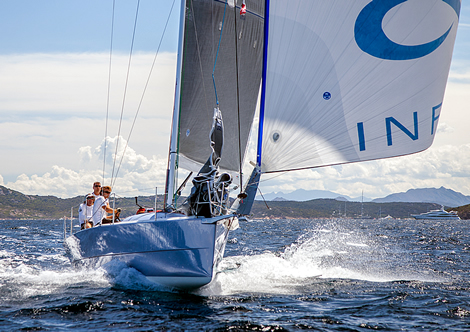








Latest Comments
Add a comment - Members log in